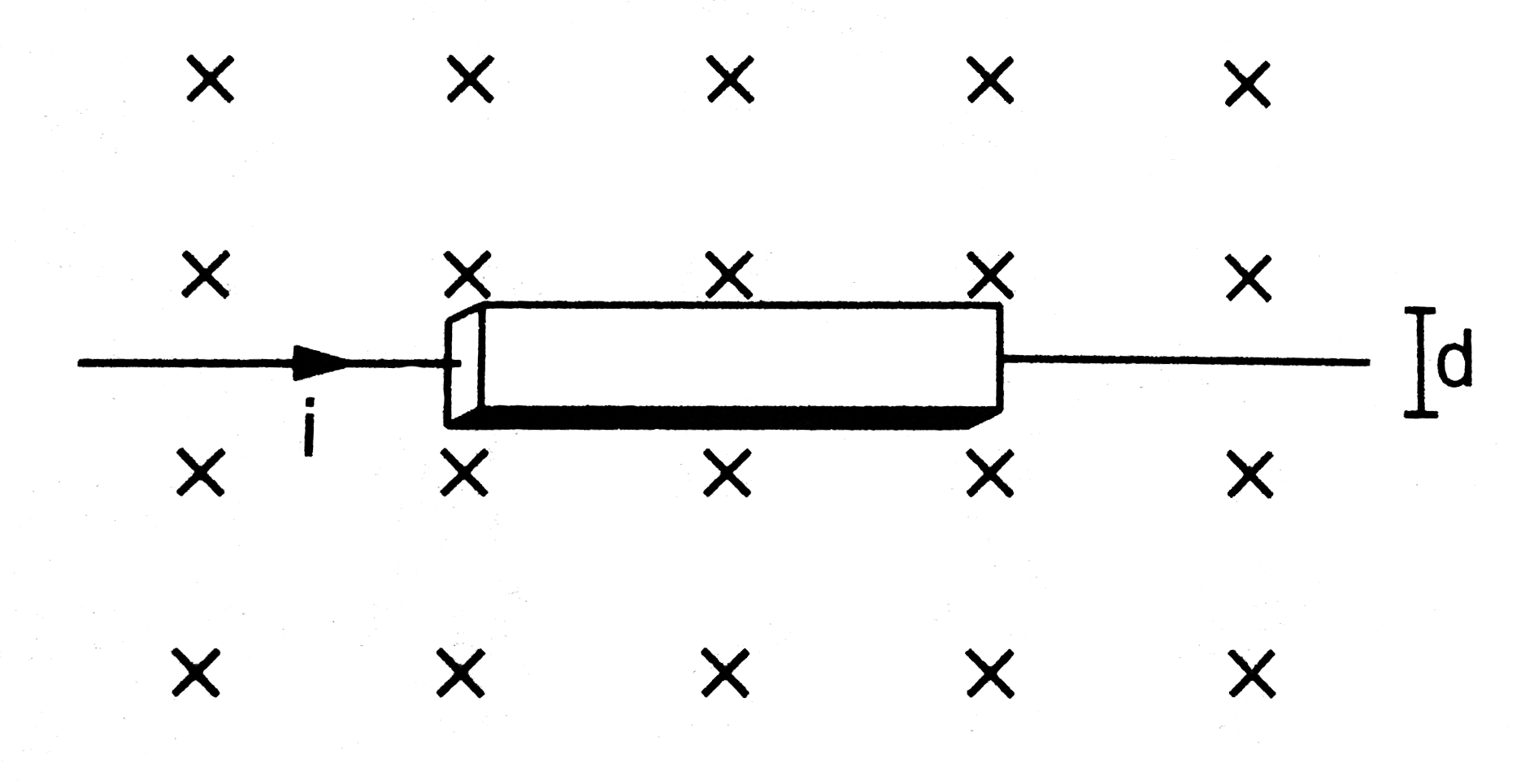A conducting wire of length l, lying normal to a magnetic field B, moves with a velocity v as shown in (a) Find the average magnetic fore on a free electron of the wire. Due to this magnetic force, electrons concentrate at one end resulting in an electric field inside the wire. The redistribution stops when the electric force on the free electrons balances themagnetic force. Find the electric field developed inside the wire when the redistribution field developed inside the wire when the redistribution stops. (c) what potential difference is developed between the ends of the wire?
 Solution in Gujrati
Solution in Gujrati
(a) Volocity of electron = V,
Force=q(V×B)=qVB
(b)F=qE,F=qVB
or qE=qVB,
oraE=eVBorF=VB
(c)V=lE=LVB.
Topper's Solved these Questions
Similar Questions
If a charged particle at rest experiences no electromagnetic force, then electric field in that region
01:43View SolutionFind the range of frequency of light that is visible to an average human being (400nm<λ<700nm)
03:25View SolutionUsing the formulae ((→F)=(→qv)×(→B)and(B=(μ0)i2πr), show that the SI units of the magnetic field B and the permeability constant (μ0) may be written as (NmA−1) and (NA−2) respectively.
03:11View SolutionThe free electrons is conducting wire are in constant thermal motion. If such a wire, carrying no current, is placed in a magnetic field, is there a magnetic force on each free electron? Is there a magnetic force on the wire?
03:45View SolutionA conducting wire of length l, lying normal to a magnetic field B, moves with a velocity v as shown in (a) Find the average magnetic fore on a free electron of the wire. Due to this magnetic force, electrons concentrate at one end resulting in an electric field inside the wire. The redistribution stops when the electric force on the free electrons balances themagnetic force. Find the electric field developed inside the wire when the redistribution field developed inside the wire when the redistribution stops. (c) what potential difference is developed between the ends of the wire?
 02:49View Solution
02:49View SolutionA currrent I is passed through a silver strip of width d and area of cross section A. The number of free electrons per unit volume is n. (a) Find the drift velocity v of the electrons. (b) If a magnetic field B exists in the region as shown in what is the average magnetic force on the free electrons? (c) Due to the magnetic force, the free electrons get accumulated on one side of the conductor along its length. This produces a transverse electric field in the conductor which opposes the magnetic force on the electrons. Find the magnitude of the electric field which will be the potential diference developed across the width of the conductor due to the electron- accumulation? The appearance of a transverse emf, when a current-carrying wire is placed in a magnetic field, is called hall effect.
 01:50View Solution
01:50View SolutionAssertion (A),If electrons travel undefeccted by the electric field E and magnetic field B then the velocity of electrons is given by V=e/b . Reason (R ) : When both electric and magnetic field are applied simultaneously on electron beam. If force due to electric field is equal and opposite to force due to magnetic field then they travel undeflected.
01:48View SolutionB అయస్కాంత అభివాహ సాంద్రత గల సమ అయస్కాంత క్షేత్రానికి లంబంగా L పొడవు గల తీగలో I విధ్యుత్ ప్రవాహం ఉండి. ఆ తీగపై గల ఏకరీతి అయస్కాంత బలం ..............
04:02View Solutionఒక సమ అయస్కాంత క్షేత్రానికి లంబంగా ఉన్న విద్యుత్ ప్రవాహం గల తీగపై పనిచేసే బలం
06:10View Solutionఅయస్కాంత క్షేత్రంలో విద్యుత్ ప్రవాహం గల తీగ θ కోణం చేస్తే దానిపై పనిచేసే బలం ఎంత ?
07:14View SolutionThe free electrons in conducting wire are in constant thermal motion. If such a wire, carrying no current, is placed in a magnetic field, is there a magnetic force on each free electron? Is there a magnetic force on the wire?
03:26View SolutionA conducting wire of length l, lying normal to a magnetic field B, moves with a velocity v as shown in (a) Find the average magnetic fore on a free electron of the wire. Due to this magnetic force, electrons concentrate at one end resulting in an electric field inside the wire. The redistribution stops when the electric force on the free electrons balances themagnetic force. Find the electric field developed inside the wire when the redistribution field developed inside the wire when the redistribution stops. (c) what potential difference is developed between the ends of the wire?
 03:10View Solution
03:10View SolutionA currrent I is passed through a silver strip of width d and area of cross section A. The number of free electrons per unit volume is n. (a) Find the drift velocity v of the electrons. (b) If a magnetic field B exists in the region as shown in what is the average magnetic force on the free electrons? (c) Due to the magnetic force, the free electrons get accumulated on one side of the conductor along its length. This produces a transverse electric field in the conductor which opposes the magnetic force on the electrons. Find the magnitude of the electric field which will be the potential diference developed across the width of the conductor due to the electron- accumulation? The appearance of a transverse emf, when a current-carrying wire is placed in a magnetic field, is called hall effect.
 06:03View Solution
06:03View Solution(A) : Free electrons always keep on moving in a conductor even then no magnetic force act on them in magnetic field unless a current is passed through it.
(R) : The average velocity of free electron in a conductor is zero in the absence of the electric field in it.58:37View SolutionThe induced force of force between the ends of the moving wire in a magnetic field depends on
View Solutionચુંબકીયક્ષેત્રમાં મૂકેલા વિદ્યુતપ્રવાહધારિત તાર પર લાગતા બળનું સૂત્ર મેળવો.
02:14View Solution

